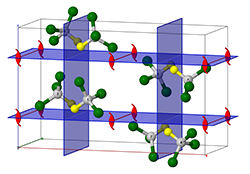Crystallographic Web Pages

Structures and Unit Cells of Ionic Materials
This site is a 3D interactive introduction to fundamental crystal structures and unit cells of elemental and ionic materials. It includes simple cubic, body-centered cubic, and cubic and hexagonal close packing unit cells as well as examples showing filling of interstitial holes.
Visual representations and controls highlight the layer patterns and coordination number for the different structures. “Cutaway” renderings illustrate the contents of the different unit cells. Ionic examples include cesium chloride, sodium chloride, nickel arsenide, zinc sulfide (two forms) and sodium oxide (antifluorite).

Space Group Visualization
The space group visualization site illustrates the symmetry elements and operations of seven common space groups using either simple asymmetric objects or example molecules. The full set of symmetry operations are shown as a table grid to show how every molecule in the unit cell is related to all the others.
Clicking on any operation in the table generates a representation of that operation and double-clicking initiates an animation. This can serve as an excellent introduction to diificult to visualize operations such as glide planes and screw axes.

Fourier Transform / Diffraction simulation
This page displays a simple shape or set of shapes and the corresponding Fourier transform. The simulation serves as an excellent companion to the popular Optical Transform laser pointer demonstration. A set of simple controls allows variation of the real space image using dots or shapes arranged as single objects or in 1D or 2D arrays.
Changing the size and spacing helps reinforce the reciprocal relationship between the shape(s) and the resulting diffraction pattern.

Crystallographic Point Groups
This page illustrates the symmetries of the 32 crystallographic point groups as solid objects decorated with patterns to give the appropriate symmetry. These representations were adapted from figures presented in Ashcroft and Mermin, Solid State Physics. Thanks to José Freire (Universidade Federal do Paraná, Brazil) for the suggestion.